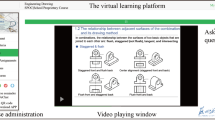Abstract
Using online video presentations is increasingly gaining ground in higher education. Our present paper discusses the initial results of a longer research project and investigates the effect that the availability of online videos introduced to complement live presentations has on learning performance. The quasi-experimental research covered each college year and each course of the college including the business faculty. Results have shown that the availability of online videos resulted in significant improvement in semester grades and it contributed to reducing dropout rates.

Similar content being viewed by others
Explore related subjects
Discover the latest articles, news and stories from top researchers in related subjects.References
Aczél, P. (2014). Az új média, kultúra, műveltség. Médiatudatosság az oktatásban. Budapest: OFI.
Allen, I., & Seaman, J. (2012). Changing course: Ten years of tracking online education in the United States. Babson Survey Research Group and Quahog Research Group.
Boda, G., Juhász, P., & Stocker, M. (2009). A tudás mint termelési tényező. Közgazdaság, 3, 117–133.
Chiu, C., Lee, G., & Yang, J. (2006). A comparative study of post-class lecture video viewing. Proceedings of the 5th IASTED international conference on web-based education (pp. 126–130). ACTA Press.
Crippen, K., & Earl, B. (2004). Considering the effectiveness of web-based worked example in introductory chemistry. Journal of Computers in Mathematics and Science Teaching, 23(2), 151–167.
Day, J., & Foley, J. (2006). Evaluating web lectures: A case study from HCI. Proceeding CHI ’06 extended abstracts on human factors in computing systems, 195–200.
DeVaney, T. (2009). Impact of video tutorials in an online educational statistics course. MERLOT Journal of Online Learning and Teaching, 5(4), 600–608.
Dupuis, J., Coutu, J., & Laneuville, O. (2013). Application of linear mixed-effect models for the analysis of exam scores: Online video associated with higher scores for undergraduate students with lower grades. Computers & Education, 66, 64–73.
Figlio, D., Rush, M., & Yin, L. (2010). Is it live or is it Internet? Experimental estimates of the effects of online instruction on student learning. National Bureau of Economic Research Working Paper.
Gálik, M., & Urbán, Á. (2014). Bevezetés a médiagazdaságtanba. Budapest: Aula.
Giannakos, M. N., & Vlamos, P. (2013). Using webcasts in education: Evaluation of its effectiveness. British Journal of Educational Technology, 44(3), 432–441.
Hove, M., & Corcoran, K. (2008). If you post it, will they come? Lecture availability in introductory psychology. Teaching of Psychology, 35(2), 91–95.
Jenkins, H. (2008). Convergence culture - where old and new media collide. New-York: NYU Press.
Kenesei, Z., & Kolos, K. (2007). Szolgáltatásmarketing-, menedzsment. Budapest: Alinea.
Kurtz, B. L., Fenwick Jr., J. B., & Ellsworth, C. C. (2007). Using podcasts and tablet PCs in computer science. Proceedings of the 45th annual ACM Southeast regional conference, (pp: 484–489). Winston-Salem, NC, USA.
Lovelock, C. (1983). Classifying services to gain strategic marketing insights’. Journal of Marketing, 47, 9–20.
Morales, C., Cory, C., & Bozell, D. (2001). A comparative efficiency study between a live lecture and a Web-based live-switched multi-camera streaming video distance learning instructional unit, Ontario, Canada, 2001, pp. 63–66. Proceedings of the 2001 information resources management association international conference (pp: 63–66). Toronto.
Ross, T., & Bell, P. (2007). “No significant difference” only on the surface. International Journal of Instructional Technology and Distance Learning, 4(7), 3–13.
Scutter, S., Stupans, I., Sawyer, T., & King, S. (2010). How do students use podcasts to support learning? Australasian Journal of Educational Technology, 26(2), 180–191.
Tan, V. (2007). Using IT tools in teaching—IVLE, webcast lectures and powerpoint. Cdtlink, 11(3), 1–2.
Tapscott, D. (1998). Growing up digital. The rise of the net generation. Education and Information Technologies, 203–305.
Traphagan, T., Kucsera, J., & Kishi, K. (2010). Impact of class lecture webcasting on attendance and learning. Educational Technology Research & Development, 58(1), 19–37.
Veronikas, S., & Maushak, N. (2005). Effectiveness of audio and screen capture in software application instruction. Journal of Educational Multimedia and Hypermedia, 14, 199–205.
von Konsky, B., Ivins, J., & Gribbl, S. (2009). Lecture attendance and web based lecture technologies: A comparison of student perceptions and usage patterns. Australasian Journal of Educational Technology, 25(4), 581–595.
Whatley, J., & Ahmad, A. (2007). Using video to record summary lectures to aid students’ revision. Interdisciplinary Journal of e-Skills and Lifelong Learning, 3, 185–196.
Wieling, M., & Hofman, W. (2010). The impact of online video lecture recordings and automated feedback on student performance. Computers & Education, 54(4), 992–998.
Williams, A., Birch, E., & Hancock, P. (2012). The impact of online lecture recordings on student performance. Australasian Journal of Educational Technology, 28(2), 199–213.
Young, C., & Asensio, M. (2002). Looking through three ‘I’s: The pedagogic use of streaming video. In S. Banks, P. Goodyear, V. Hodgson, & D. McConnell (Ed.), Networked Learning (pp. 628–635). Sheffield.
Yunus, A., Kasa, Z., Asmuni, A., Samah, B., Napis, S., & Yusoff, M. (2006). Use of webcasting technology in teaching higher education. International Education Journal, 7(7), 916–923.
Zhang, D., Zhou, L., Briggs, R. O., & Nunamaker, J. F., Jr. (2006). Instructional video in e-learning: Assessing the impact of interactive video on learning effectiveness. Information & Management, 43, 15–27.
Online documents
EACEA. (13 October 2014). LIFE-LONG LEARNING PROGRAMME 2007–2013: http://eacea.ec.europa.eu/llp/project_reports/project_reports_en.php. Accessed: 12 Dec 2014
Education and Training. (03 December 2014). http://ec.europa.eu/education/tools/llp_en.htm. Accessed 03 Dec 2014.
Author information
Authors and Affiliations
Corresponding author
Rights and permissions
About this article
Cite this article
Nagy, J.T., Bernschütz, M. The impact of webinar-webcast system on learning performance. Educ Inf Technol 21, 1837–1845 (2016). https://doi.org/10.1007/s10639-015-9422-4
Published:
Issue Date:
DOI: https://doi.org/10.1007/s10639-015-9422-4




